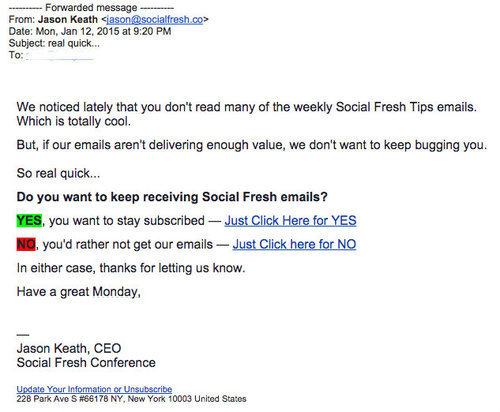Great Email For Pruning Your List
We all want to have healthy and robust subscriber lists for newsletters or other content nurturing programs. For some, sending an email blast can be like going to the ATM especially when there is an offer to buy something enclosed. For others, email can be a form of passive lead nurturing on the path to moving the recipient one step closer to engagement or conversion.
As a student and practicer of online marketing, I’m always on the lookout for new resources. In fact, I sign up for so many newsletters that I have a hard time keeping track of them. (ps – if you have a solution for this, please let me know!)
The number of subscribers you have is a vanity metric. The response or engagement rate your subscribers have per communication attempt is a much more telling metric. The numbers vary by industry but a 20% open rate and 3% click rate is a good benchmark.
An email from Social Fresh caught my attention last week and I wanted to share if here. These guys share content and provide insights on leveraging social media to improve your business. I’ve been a ‘long time listener’ without being a ‘first time caller.’ Here’s the email:

So, now what
Why I opened this email:
1) It was in my primary inbox, not promotions or social.
2) The subject line was ‘real quick…’ It’s a subject line I use and allowed me to quickly apply my FARD filter. (forward, archive, reply, delete…more on this later).
3) The reply address was the CEO/sender’s email not ‘do_not_reply@xyzbigcompany.com’ (I hate that)
Why I forwarded the email from my catch-all email address to my primary inbox?
1) I’m an email geek!
2) This is the first time I’ve been asked to unsubscribe from a list. Most of us are too nervous about upsetting a subscriber and losing more folks than gaining for every email sent. You are probably thinking: ‘who cares, they may convert at some point in the future, why ask them to leave now?’ There are a few psychological tactics in use here including reverse psychology.
3) Curiosity – why would a company want to ask customers or prospective customers to remove themselves? My mind started racing. Maybe they are segmenting their subscribers and want to know which segment is most engaged with the content so they know what topics could yield the highest engagement rates. (say what?) Maybe they want to drop into a cheaper tier for their eMail provider. Maybe they wanted to see if a big ask would impact open and click rates. We’ll save the analysis paralysis for another post, but suffice to say one, some, all or other factors could be at play.
This tees up a question I often ask of folks who hire us to consult: ‘if you owned an auto-repair company, would you rather have 100 leads who owned cars or 10 leads who are stranded on the side of the road?’
Ok. Enough speculating on my part. I sent an email to their CEO Jason Keath asking for him to comment. Here’s what we got:
“Once a year we clean up our email list for several reasons. It gives us a chance to reengage some of our audience that may have forgotten about our emails or have our newsletter going into a folder they do not check anymore. Also, if someone is just no longer interested in our emails, it is better than we remove them for our list. It means we won’t annoy them moving forward AND we prevent a possible spam complaint. It is better to be proactive and constantly cut your list down to who is truly listening and engaging with your content.
This most recent series of emails was sent to everyone on our list who has not opened an email or clicked on an email in the last 120 days. About 30% of our list fell into that category. Of those that manually chose to opt-in or opt-out, 40% stayed on the list and 60% chose to leave. Those that do not select either option will be automatically opted out.”
I love Jason’s rationale for why a startup would ever want to prune their list. Whether or not you agree with this approach, I’d love your feedback. Quick question – are you still sending emails to your prospects one by one?
Updated:  Jason’s not the only one cleaning his list. Noah Kagan, taco fanatic and doer of lots of awesome things like OkDork and AppSumo, uses this method too.
Jason’s not the only one cleaning his list. Noah Kagan, taco fanatic and doer of lots of awesome things like OkDork and AppSumo, uses this method too.
